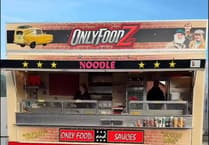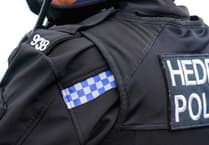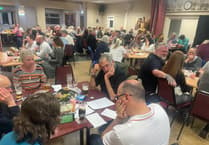GAS main renewals in Chepstow have revealed the remains of a Roman dwelling, possibly rewriting the history of the town.
Much to the excitement of Councillor and new owner of Chepstow's former public conveniences Stuart Wilson, the trenches have also revealed a lot more.
"The cross section of a Roman building with a cobbled surface nearby outside the Baptist Church shows there was actually a Roman port settlement here, although if you look at Chepstow Museum's map of the town in Roman times there is nothing near the river except a bunch of trees," he said.
Roman pottery was found on both sides of the central stone. The stone itself is similar to stone used in the earliest phases of Chepstow Castle, which itself is thought to be of Roman origin.
A large stone in the centre of the trench is on a flat surface and looks to be in situ as do the cobbles by it, and thus looks to be the first evidence of Roman habitation inside Chepstow, previously suggested by alignments of Roman roads, various scattered Roman finds and evidence of a Roman cemetery under the car park by the Priory discovered by Ron Shoesmith
in his excavations in 1973-1974.
Nearby a large flat stone with another one next to it running across the trench seems to be of a well-constructed building running east-west (the same alingment as the church). A medieval tile was discovered with it and it may well be part of an medieval building relating to the Priory Church before the later construction of Lower Church Street. This discovery was just a few metres up the road from the Roman discovery.
A medieval building was found in a medieval road at the bottom of St Mary Street. Further left of this several clay floor levels were recorded with medieval pottery and iron slag.
A thick wall was found at the bottom of the trench at the top end of St Mary Street outside Coffee #1. Its width is the full length of the ranging pole and pre-dates the medieval street. Its sturdy construction, thickness and clay bonding along with associated medieval pottery, means the only comparable walls in Chepstow are the Port Wall and Castle.
This wall in St. Mary Street may well be evidence of an earlier town defence before the construction of the Port Wall.
Mr Wilson said things were starting to point to a Roman crossing on the Wye in Chepstow rather than the current belief the road from Caerwent to Tutshill looped away from the town to join up. The ends of the roads on both sides were staggered rather than in a straight line, allowing for the influence of tides on a ferry boat.
"We also found the later buried remains of a few bodies by the church wall. We had to call the police in about that," he said.
Mr Wilson and his fellow archaeologists have been cataloguing their finds and trying to piece together more of the town's past. They are unlikely to learn more for the time being because the gas work trenches have all been filled in.




